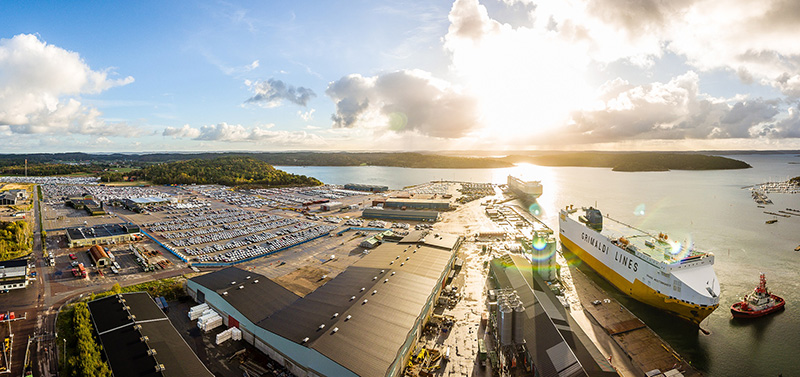The first half of 2017 has seen a partial recovery in deep-sea shipments of new light vehicles. Management consultancy Maritime Strategies International (MSI) estimates that global shipments will be up around 3% during the first half of 2017, compared to the same period in 2016.
According to Niklas Carlén, research director at MSI, although shipments on the dominant flow from Asia to North America have decreased this year on the back of declining US sales, this has been offset by a recovery in Asia to Europe trade, with buoyant European sales and a partial Russian sales recovery. South American sales and import volumes have also staged a partial recovery during 2017, though Carlén says shipments to Africa and the Middle East remain weak.
Elsewhere, high-and-heavy volumes, which are also important to ro-ro lines, have improved during 2017 on the back of stronger sales of construction and agricultural equipment, but the recovery here remains uneven from region to region. Carlén says an improvement in mining commodity prices is driving renewed mining capital expenditure, which is expected to increase by 2.4% in 2017 and 3.6% in 2018, according to consensus forecasts.
“However, the recovery needs to be viewed in the context of the 2012-2013 capex [capital expenditure] peak, with capex currently 60% below those levels. MSI forecasts global high-and-heavy deep-sea shipments to grow by 10% this year, but from a low base,” he comments.
As of August 1st, Carlén says there were some 759 vessels above 1,000 CEU (car equivalent units) in size in the global PCTC and ro-ro fleet, with 10 vessels still scheduled for delivery during the remainder of the year and a further 21 vessels due to be delivered during 2018.
“The widening of the Panama Canal has also seen the emergence of neo-Panamax vessels with wider beams and 15-20% more cargo capacity,” adds Carlén.
Although the global ro-ro sector has faced tough times over the last few years, Costantino Baldissara, commercial and logistics director at Grimaldi, says the market has picked up of late. He points to new investments across existing and new ports in space and extended shipping services to overcome increasing port congestion issues.
Christina Kavanagh, compliance and public relations manager at NYK Group Europe, confirms that many lines are having to pay close attention to optimal fleet configuration when building new ships, with a particular focus on including ‘post-Panamax’ type vessels after the lock-widening project at the Panama canal.
Kavanagh also suggests liquefied natural gas (LNG)-fuelled vessels may increase in number in coming years, with shipping lines also needing to consider short-term chartering or replacement of vessels in light of anticipated demand. “There is also a trend to expand the number of port calls, especially due to congestion in the major ports, and this has a clear cost burden to the parties,” she says.
“Of approximately 90m cars sold per annum, around 30% are transported by vessel. Automobile manufacturers are increasingly mass-producing cars in the optimal location for maximum efficiency, and while transportation within the region has been revitalised, the trend is towards a decrease of long-distance transportation,” Kavanagh adds.
Logistics consultant Dr. Hans-Bert Bong, who used to work at Ford Europe leading outbound and later inbound logistics, believes the global ro-ro market is currently influenced by the three megatrends of efficiency, economy of scale and the need to reduce environmental damage. Although historically, shipping companies have sought to sail faster, most lines now try to conserve fuel by sailing at 15-20 knots, he says.
“Time can be gained by improved dwell time in ports, where currently waiting times are an increasing problem. New IT such as blockchain also offers better visibility of the supply chain and with that, better capacity planning without paperwork,” Bong says.
In terms of market structure, there are indications that the tentative return to growth could be accompanied by increasing consolidation throughout the global ro-ro and pure car and truck carrier (PCTC) sector.
After some moves in this direction in prior years, Bong says the deep-sea shipping of vehicles is now performed by a limited number of players, some of which have already formed joint ventures or strategic alliances that operate feeder lines or ro-ro terminals.
One company making such changes is Wallenius Wilhelmsen Logistics (WWL), which is currently undergoing a significant restructuring process, following the consolidation of activities across its two owners, Wallenius and Wilhelmsen, the formation of WWL ASA on the Oslo stock exchange and the merging of activities across its various shipping lines.
Elsewhere, Norway-based Höegh Autoliners has recently acquired services and operations from SC Lines in Latin America and has been expanding its terminal operations in the US and elsewhere through its Horizon Terminal division.
“Consolidation is pursued by all major industries, considering the necessity to increase economies of scale and to avoid industry inefficiencies,” says Baldissara. “This is part of the globalisation process. Consolidation is also pursued by the shipping sector in general and not only the car-carrier or ro-ro one.”
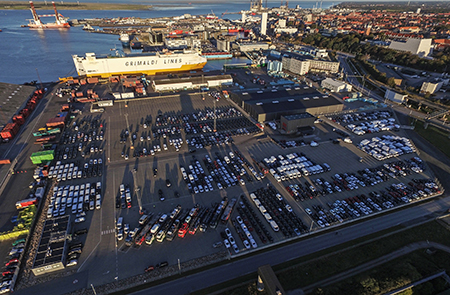
Craig Jasienski, president and chief executive at WWL, confirms that the company is “fine-tuning” its suite of carriers in the market in an effort to ensure it continues to meet the cost and quality demands of manufacturers and buyers of its sea transport services.
“We operate in a very competitive marketplace with tight margins and a constant need to seek efficiencies in everything from the vessel assets to seagoing operations and the very capable organisation needed to make it all happen,” he says. “Financial necessity or indeed demands from the manufacturers themselves can be the likely triggers of any future consolidation in our industry.”
Clear air above clean watersAlthough continued market restructuring is perhaps likely over coming years, Jasienski stresses that the decision by the International Maritime Organization (IMO) to ratify the 0.5% sulphur cap by 2020 is “without doubt the most significant recent development for ocean shipping”.
This effectively means that heavy fuel oil (HFO) will be “off the menu, unless the vessel has a scrubber”, he says. He welcomes the move as a good step forward for the sustainability of the industry. Although he warns it will come at a certain cost to the outbound supply chain, consumers “can readily absorb that cost in the price of their new car”.
While Jasienski describes the cost of compliance relative to the underlying cost and revenue achieved per unit as “massive” for the carriers concerned, the additional cost of compliance is a small fraction of what dealerships would typically throw into the final sales price of a car in any market to make a sale.
"The next few years remain a big question mark, particularly considering the uncertainty related to US foreign policy as well as Brexit effects. However, virtuous shipping companies will keep on investing in bigger capacities and green technologies, aiming to reduce emissions and energy costs." - Costantino Baldissara, Grimaldi
"We are positive about the development – we just cannot carry the cost burden alone,” he says. “WWL’s view is that taking an environmentally sustainable approach is ultimately about the sustainability of our industry in the broadest sense of the term; therefore, it’s something we embrace.”
Using the historical differential between HFO and marine gas oil as a guide, Jasienski believes it would be reasonable to expect an increase in bunker cost of around 50%. Carriers also face multimillion dollar outlays to comply with ballast water regulations intended to mitigate the risk of transferring an organism in such water from one ecosystem to another, with potentially harmful effects for indigenous species.
“After sulphur and invasive species, the elephant in the room of regulatory development is of course CO2. The IMO has already introduced the first global regulation for design efficiency of new vessels and shortly regulation from both the EU and IMO requiring mandatory measurement, reporting and verification of CO2 emissions will be in place,” he says.
“The impact of these on shippers of finished vehicles is not great, but that may not be true for the regulations that can be expected in future,” he adds.
As far as European waters are concerned, says Poul Woodall, director, environment and sustainability at DFDS, the sheer number of new regulations affecting shipping markets, from both the IMO and the EU, has been the main challenge in recent years.
In particular, he believes, the imminent 0.5% global sulphur cap will “substantially increase the cost of all shipping” and the Energy Efficiency Design Index (EEDI), in particular for ro-ro vessels, will remain a challenge that could make new builds both difficult and expensive to design and build.
“The ballast water convention also hits all shipping, but again, a substantial cost is involved with retrofitting ships over the coming five-year period. The big unknown is how CO2 will be costed by the regulators, I see this as something that will come in the medium term,” he says.
While the regulatory challenges facing the ro-ro sector are “not much different” to those facing the shipping industry as a whole, Erik Lewenhaupt, head of sustainability at Sweden’s Stena Line, believes that the mandatory global bunker sulphur cap for 2020 and the installation of ballast water treatment systems (BWTS) in coming years are the regulations that will have the most short-term effect.
“In most shipping segments, the market is at record lows and there is speculation that these regulations will therefore lead to increased scrapping of older ships. In ro-ro, I don't think that will be the case, while in PCCs [pure car carriers] it may more strongly influence a decision to upgrade or scrap,” he says.
“At the same time, the industry needs to stay ahead of road and air in environmental matters, so we welcome these regulations. That there is overcapacity in some segments should not stop the industry from being proactive. No one has been able to miss the gradual electrification of road transportation so if shipping doesn’t start acting now, it will be our loss,” he adds.
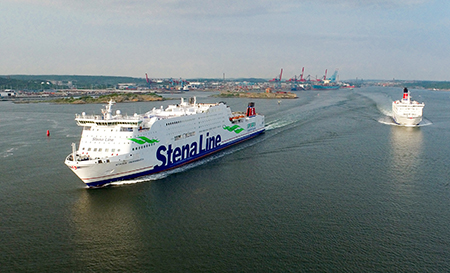 Stena Line is currently running a trial to test the use of methanol as a fuel and is also planning to conduct a battery propulsion trial during the course of 2018
Stena Line is currently running a trial to test the use of methanol as a fuel and is also planning to conduct a battery propulsion trial during the course of 2018For CO2 emissions reduction, Lewenhaupt says that while Stena Line is positive about the implementation of a global system, it would consider a parallel EU system as challenging for administration and competition and calls for a quick response and thorough enforcement from the IMO instead.
Meanwhile, support for technical development and first movers is needed at local levels, he adds. “The vast majority of our ships, and the global fleet of 50,000 ships, is dependent on fossil bunkers. In Stena, we have a trial with methanol ongoing,” he says. “We are [also] planning a battery propulsion trial for 2018 [and] others are trying fuel cells, hybrids and LNG.
“I am positive, as there are plenty of alternatives under development, but starting from a low level. It remains to be seen which one can be safe, clean, available and competitive.”
Electric propulsionLooking ahead, Jasienski predicts that changes in the way business is transacted globally through technology will be one trend affecting the global ocean shipping market for finished vehicles in the future. In particular, he says, although bills of lading have been in use for centuries, evolving technology could make them obsolete.
“We all readily fly airlines on e-tickets and often without paper boarding cards – and the fact that there remains an electronic record of that flight transaction instead of paper is a given, as it is with bills of lading,” he says. “But how will technology abolish the need for that antiquated method of confirming a shipping transaction and title of ownership?”
At WWL, Craig Jasienski accepts that another important technological challenge in coming years is the need to decouple shipping from its dependence on fossil fuels. While he acknowledges the existence of alternative power sources that can contribute to emissions reductions for some types of vessels, he argues that there is “not yet any viable alternative to fossil fuels as a primary source of energy for the world’s ro-ro fleet”.
“However, fortunately, there are a growing number of, as yet esoteric, alternatives that, at least in theory, have the potential to become the true fuel of the future,” he adds.
At Grimaldi, Costantino Baldissara agrees that “the future needs to be green” and he singles out improved environmental performance as an “unavoidable commitment” that the ro-ro and vehicle shipping industry cannot postpone any longer than other shipping segments.
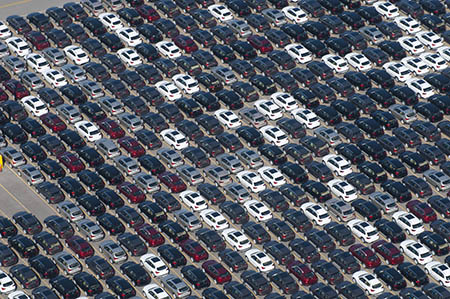 Recovering vehicle sales in Europe, in particular, have helped to offset a decline in US sales this year and contributed to an overall rise in deep-sea shipping volume
Recovering vehicle sales in Europe, in particular, have helped to offset a decline in US sales this year and contributed to an overall rise in deep-sea shipping volume“Grimaldi is working hard from this perspective, aiming to contribute to a safer and sustainable environment. We aim to reduce sulphur emissions with new buildings in our portfolio, as well as emissions during port stops through a revolutionary lithium-battery system that is under study through our research and development department,” he says.
“The next few years remain a big question mark, particularly considering the uncertainty related to US foreign policy as well as Brexit effects,” continues Baldissara. “However, virtuous shipping companies will keep on investing in bigger capacities and green technologies, aiming to reduce emissions and energy costs.”
Elsewhere, Poul Woodall at DFDS suggests that as with cars, most ships will one day be electrically powered, but stresses that a technological breakthrough is required first for it to be feasible. On a similar note, Stena’s Lewenhaupt predicts that “several techniques will cross over from road to sea and vice versa”, and singles out electric and hybrid technology as the most logical.
“One can imagine that quite soon, we will see ships with electric propulsion leaving the port and switching to another fuel for main engines when in open sea,” he says.
“A challenge will be battery sizes and price. In our planned trial, we will have a battery with the capacity of 10 Tesla [electric vehicles] but at the price of 20 – and that’s only for one auxiliary engine. For the main engines, you need a capacity of more than 200 electric cars.”
“I think we will also see an increase in [the use of] new materials when building ships, as well as autonomous ships or at least smaller crews – and increased automation on-board. Ships will be more efficient and effective, but likely not any bigger,” concludes Woodall.
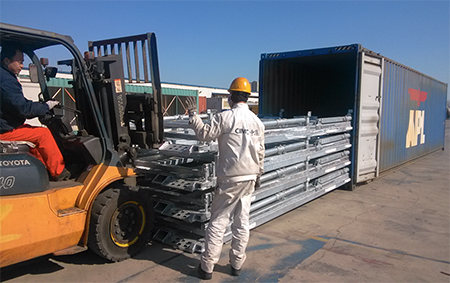 Growing interest in the China-Europe railway could be a source of growing competition to shipping lines serving particular regions between Asia and Europe
Growing interest in the China-Europe railway could be a source of growing competition to shipping lines serving particular regions between Asia and EuropeAs the global ocean shipping market continues to grapple with a variety of technological and regulatory challenges, there are some signs that rail operators are beginning to muscle into the long-distance finished vehicle logistics sector – particularly over the increasingly lucrative China to Europe routes.
One of the companies involved in this sector is Chinese outfit CDC International Logistics, founded in 2011 as a subsidiary of Changjiu Logistics, which has recently started shipping thousands of units annually from the new Volvo Car plant in Daqing, in north-east China, to the port of Zeebrugge, in Belgium.
As Vegard Synnes, head of key accounts at CDC, explains, Changjiu Logistics currently possesses majority ownership in HAO International Logistics, the railway operator on the northern railway route between Harbin (in the north-east of China) and Europe – and has “already been sending automotive parts for Audi from Europe to China using this route for several years”.
“After getting in contact with Volvo regarding their upcoming export, the pieces kind of fell together for big-scale transportation of vehicles on the railway,” he adds. “We do, however, hope to build on this and establish bi-directional flows, including also other OEMs in the future.”
Although Volvo is the first carmaker to use the route for transport of any significant quantity of vehicles, Synnes is confident the number of interested companies will increase over the coming year – particularly in terms of Chinese OEMs like Geely, BYD, NIO (formerly NextEV), Beijing Automotive and Changan, which, he argues, are likely to have vehicles approved in western markets soon.
“When this happens, railway transportation can be a viable option. It also has to be mentioned that plant location in China will have a significant role to play. Volvo’s Daqing plant is located far inland in the north-east of China. Looking at SAIC, which has several plants in the Shanghai region, using the railway for transportation will likely not be very lucrative. Nevertheless, I believe it will increase,” he says.
For Synnes, the biggest advantage of rail compared to ocean-based ro-ro is the reduced time to get vehicles to market, which he argues will reduce the capital tied up during transport and “enable carmakers to respond faster to market changes in Europe and perhaps even do customisations in China on order from the end customer”. In his view, use of rail will also reduce the fallout from uncontrollable events. “Having a block train with 220 vehicles tied up at a border will have far less impact than a ro-ro with 2,000 vehicles having to take shelter in a port,” he says.
“Another advantage, of course, is location,” he continues. “Manufacturing in China is undeniably moving more and more inland. If the choice is between putting your export vehicle on a direct train, which will take 18 days to reach Europe, or having to use road, rail or river transportation, taking anything between 3 and 10 days to reach Shanghai, from where it can then be put on an international ro-ro vessel, which again takes 35-40 days to get to Europe, the choice should be simple,” he says.
In the future, Synnes predicts steady growth in the use of the new Silk Road railway for vehicle transport, but admits that some outstanding issues must be addressed – not least the need to make railway logistics sustainable without relying on subsidies from the Chinese government, as well as the need to address variables like transit time, border crossings with gauge-changes and customs clearance speed. Still, there is strong potential, especially for western regions in China.
“Inland cities such as Chengdu, Xian and Chongqing are experiencing a rapid growth in wealth and purchasing power. Beijing and Shanghai have traditionally been the biggest market for imported vehicles in China, but other tier two and tier three cities will definitely also have a higher demand for imported vehicles in the future,” he points out. “Then, it will make sense to use the railway to transport directly to destination instead of transhipping through the coastal cities.”


























![Global[1]](https://d3n5uof8vony13.cloudfront.net/Pictures/web/a/d/s/global1_726550.svgz)




